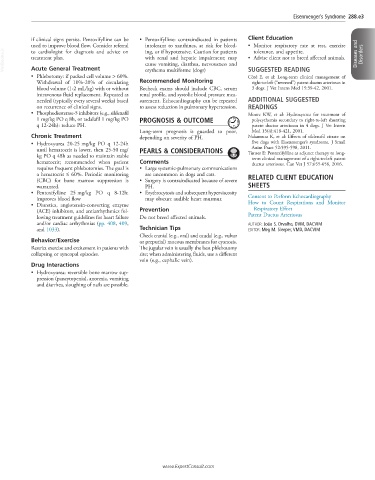Page 634 - Cote clinical veterinary advisor dogs and cats 4th
P. 634
Eisenmenger’s Syndrome 288.e3
if clinical signs persist. Pentoxifylline can be • Pentoxifylline: contraindicated in patients Client Education
used to improve blood flow. Consider referral intolerant to xanthines, at risk for bleed- • Monitor respiratory rate at rest, exercise
VetBooks.ir treatment plan. with renal and hepatic impairment; may • Advise client not to breed affected animals. Diseases and Disorders
ing, or if hypotensive. Caution for patients
tolerance, and appetite.
to cardiologist for diagnosis and advice on
cause vomiting, diarrhea, nervousness and
Acute General Treatment
• Phlebotomy: if packed cell volume > 60%. erythema multiforme (dogs) SUGGESTED READING
Côté E, et al: Long-term clinical management of
Withdrawal of 10%-20% of circulating Recommended Monitoring right-to-left (“reversed”) patent ductus arteriosus in
blood volume (1-2 mL/kg) with or without Recheck exams should include CBC, serum 3 dogs. J Vet Intern Med 15:39-42, 2001.
intravenous fluid replacement. Repeated as renal profile, and systolic blood pressure mea-
needed (typically every several weeks) based surement. Echocardiography can be repeated ADDITIONAL SUGGESTED
on recurrence of clinical signs. to assess reduction in pulmonary hypertension. READINGS
• Phosphodiesterase-5 inhibitors (e.g., sildenafil Moore KW, et al: Hydroxyurea for treatment of
1 mg/kg PO q 8h, or tadalafil 1 mg/kg PO PROGNOSIS & OUTCOME polycythemia secondary to right-to-left shunting
q 12-24h): reduce PH. patent ductus arteriosus in 4 dogs. J Vet Intern
Long-term prognosis is guarded to poor, Med 15(4):418-421, 2001.
Chronic Treatment depending on severity of PH. Nakamura K, et al: Effects of sildenafil citrate on
• Hydroxyurea 20-25 mg/kg PO q 12-24h five dogs with Eisenmenger’s syndrome. J Small
until hematocrit is lower, then 25-50 mg/ PEARLS & CONSIDERATIONS Anim Pract 52:595-598, 2011.
kg PO q 48h as needed to maintain stable Turner E: Pentoxifylline as adjunct therapy to long-
term clinical management of a right-to-left patent
hematocrit; recommended when patient Comments ductus arteriosus. Can Vet J 57:655-656, 2016.
requires frequent phlebotomies. The goal is • Large systemic-pulmonary communications
a hematocrit ≤ 60%. Periodic monitoring are uncommon in dogs and cats. RELATED CLIENT EDUCATION
(CBC) for bone marrow suppression is • Surgery is contraindicated because of severe
warranted. PH. SHEETS
• Pentoxifylline 25 mg/kg PO q 8-12h: • Erythrocytosis and subsequent hyperviscosity
improves blood flow may obscure audible heart murmur. Consent to Perform Echocardiography
• Diuretics, angiotensin-converting enzyme How to Count Respirations and Monitor
(ACE) inhibitors, and antiarrhythmics fol- Prevention Respiratory Effort
lowing treatment guidelines for heart failure Do not breed affected animals. Patent Ductus Arteriosus
and/or cardiac arrhythmias (pp. 408, 409, AUTHOR: João S. Orvalho, DVM, DACVIM
and 1033). Technician Tips EDITOR: Meg M. Sleeper, VMD, DACVIM
Check cranial (e.g., oral) and caudal (e.g., vulvar
Behavior/Exercise or preputial) mucous membranes for cyanosis.
Restrict exercise and excitement in patients with The jugular vein is usually the best phlebotomy
collapsing or syncopal episodes. site; when administering fluids, use a different
vein (e.g., cephalic vein).
Drug Interactions
• Hydroxyurea: reversible bone marrow sup-
pression (pancytopenia), anorexia, vomiting
and diarrhea, sloughing of nails are possible.
www.ExpertConsult.com

